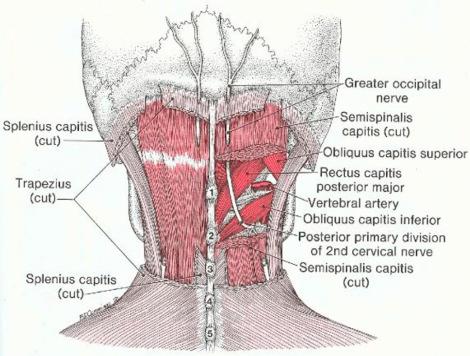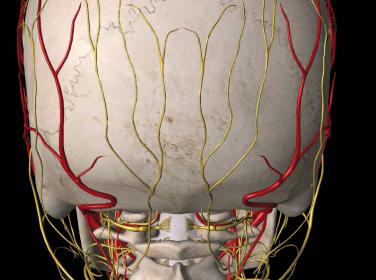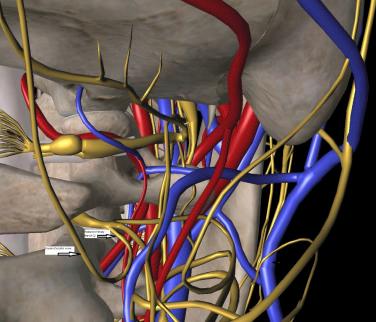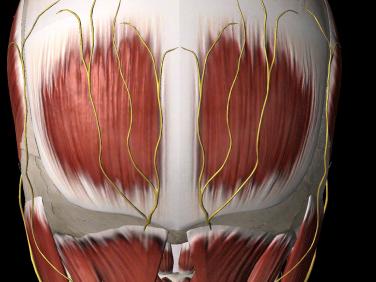Physical Address
304 North Cardinal St.
Dorchester Center, MA 02124
Occipital nerve stimulation (ONS) has matured significantly over the past 40 years in terms of a better understanding of the indications for its use and implant techniques necessary for a successful outcome. Picaza et al. in reported placing coiled electrodes around dissected exposed occipital nerves, with favorable results in controlling occipital neuralgia pain. Following the publication of initial data and a technique description using percutaneously placed wired electrodes in the region of the occipital nerves ( ), the inclusion of ONS as part of the chronic pain treatment armamentarium for a variety of intractable headache conditions has become mainstream despite its continued off-label status to date.
Chronic headache syndromes continue to be clarified and reclassified by the International Headache Society’s newest version of the International Classification of Headache Disorders (third edition, beta, 2013), with a 2017 full release ( ). This classification scheme is available as a free download to any smartphone or tablet at https://www.ichd.org . Its importance is underscored by the fact that while most of the original patients reported in the 1999 neuromodulation paper ( ) had favorable outcomes from ONS implants, they were later reclassified as chronic migraine patients by several neurologists ( ) rather than having occipital neuralgia. This has led to several multicenter studies by industry, at times without a clear understanding of inclusion and exclusion criteria, that failed to reach the 50% or greater threshold of improvement for United States Food and Drug Administration clearance ( ).
Primary headache disorders are a dominant presentation in most neurology, pain management, and primary care practices worldwide. Intractable migraine, chronic daily headache (CDH), and secondary headache syndromes such as cervicogenic headache and occipital neuralgia affect almost 40 million Americans and many more millions worldwide ( ). It is estimated that up to 5% of these headache sufferers experience daily or near-daily headaches (transformed migraine, CDH), and 1%–2% are so poorly responsive to medication paradigms that this failure can lead to narcotic dependence, severe restrictions in daily activities, failed personal and career objectives, and an overwhelming sense of hopelessness and despair.
Specifically, CDH refers to a group of nonparoxysmal headaches, including those associated with overuse of symptom-relieving medications, that present on a daily or near-daily basis with a duration longer than 4 h a day and lasting longer than 6 months ( ). Its prevalence in the general population varies from 0.5% to 6%, approximating 2.2 million patients ( ). Annual direct costs of episodic migraines are over $1 billion, and they cost American employees $13 billion a year in absenteeism ( ).
A large percentage of patients with CDH have had episodic migraine in the past. Episodic migraine sufferers tend to range in age from 25 to 45 years, with peak prevalence at age 40. Women are five times more likely to experience migraines than men. Females tend to have more frequent occurrences of migraine. There are an estimated 28,000,000 migraineurs in the United States; 15% have migraine with aura and 85% have migraine without aura ( ). With increased frequency of episodic migraine and time, migraine patients show a progressive change or loss of specific migraine characteristics and present with a daily or near-daily headache, with mixed clinical features of migraine and tension-type headaches ( ). These patients typically have an 80% chance of symptomatic overuse of pain-relieving medicines, including simple analgesics, narcotics, and other symptomatic medications ( ). Interestingly, these patients with transformed migraine only make up approximately 5% of headache prevalence but are responsible for the vast majority of treatment costs. Such patients commonly present with episodic migraine early in life which later becomes chronic and progressive. The natural progression of disease is that of relapsing progressive disease. Migraine transformation is a critical aspect of patient treatment. Physicians play a pivotal role in preventing CDH. It is important to control acute medications, to ensure that acute migraine attacks are treated properly. Symptomatic medication overuse should also be addressed, especially in this era of national and international opiate overuse and abuse.
Treatment options for almost all headache syndromes have centered on a variety of medication management paradigms including acute pain relieving, as well as, preventative measures. Pharmacological treatment is traditionally divided into acute or symptomatic treatment, and preventive treatment or prophylaxis. Many migraine patients can be treated using only acute treatment that is, prescribing medications that are used only during headache attacks to abort an ongoing attack or to stop its progression to severe pain and associated symptoms. Patients with severe and/or frequent migraines require long-term preventive therapy.
Medication options fall into a number of categories and include, but are not limited to, NSAIDS, triptans, opioids, ergot compounds, antiseizure medications, tricyclic antidepressants, beta blockers, serotonin antagonists, calcium channel blockers, and sedatives. Alternative medications including vitamins, minerals, and herbal products have their proponents as well. Nonmedication strategies can include biofeedback, relaxation therapy, cognitive behavioral therapy, acupuncture, and diet control ( ).
Medication side-effects and overuse are significant factors limiting successful management of chronic headache conditions. Evidence-based guidelines have offered goals for migraine preventive treatment to reduce attack frequency, severity, and duration; to improve responsiveness to treatment of acute attacks; and to improve function and reduce disability. Additional goals are to decrease costs of migraine management and perhaps prevent the evolution of episodic to chronic migraine. Unfortunately, it is estimated that up to 40% of headache sufferers are not on appropriate medication and a small percentage (3%–14%) will transform into chronic, daily, intractable headache sufferers unresponsive to medication management ( ).
The neurosurgical literature has tended to diagnose localized occipital pain as occipital neuralgia due to a variety of secondary issues such as tumor, trauma, infection, systemic disease, or hemorrhage. Upper cervical osteoarthritis, spondylosis, and C2/C3 nerve root impingement/compression, when found, can be surgically corrected. Occipital nerve neurolysis and/or neurectomy have been part of the neurosurgical armamentarium for treating intractable occipital headaches for many years. Though occasionally very effective, the not-infrequent development of delayed deafferentation pain in the distribution of the affected occipital nerve limits the long-term usefulness of this procedure. C2 ganglionectomy ( ) for posttraumatic C2 pain syndromes resulted in an 80% good to excellent outcome with a 3-year follow-up. Patients with nontraumatic C2 pain did not fare nearly as well as those with traumatic C2 pain, and subtle but significant morbidity, including postoperative dizziness and gait disturbances, may be a persistent problem.
C2 nerve decompression ( ) achieves up to a 79% success rate, with 33% complete pain relief and 46% adequate pain relief over 2 years. C1–C2 fusion ( ) corrects focal instability and may be indicated on occasion. C1–3 posterior rhizotomy ( ) with a ventrolateral to dorsal root entry zone at C1–3 levels can be an effective but highly invasive surgical technique. Neurolysis of the greater occipital nerve ( ) can be effective in the short term, but most patients tend to have significant recurrences within 1–2 years.
The neurology literature views occipital neuralgia as a rather rare pain syndrome, characterized by periodic lancinating pain and involving the distribution of the occipital nerve complex. The pain is described as a paroxysmal, severe, lightning-like sharp headache in the distribution of the greater or lesser occipital nerves. The majority of occipital pain presentations are more likely to be variants of migraine, from episodic headaches with occipital triggers all the way to intractable transformed migraines presenting as CDH. Medical management is the mainstay of therapy ( ).
Neuromodulation for treatment of chronic pain disorders over the past 40 years has centered on spinal cord stimulation and peripheral nerve stimulation (PNS) of specific nerves that use implanted electrode and generator devices to modulate perception of abnormal pain signals to the brain. PNS implants require exposure of the affected nerve with placement of either coiled or paddle electrodes adjacent to the site of injury or involvement. Picaza reported pain suppression by PNS on six patients with occipital neuralgia using a cuff electrode technique, with 50% of patients reporting a good outcome ( ). Waisbrod reported a very good result from stimulation of the greater occipital nerve for painful peripheral neuropathy ( ). In 1999 we reported the first successful neurostimulation and control of occipitally mediated headache pain with a percutaneous electrode placement technique at or near the level of C1 in the vicinity of the greater and/or lesser occipital nerves within the subcutaneous tissues ( ).
The greater occipital nerve is the medial branch of the dorsal primary ramus of the C2 spinal nerve. This nerve arises between the first and second cervical vertebrae, along with the lesser occipital nerve. It passes through the semispinalis and trapezius musculature just inferior to the superior nuchal line, then continues superiorly above the fascia and below the galea, with several branches innervating the skin along the posterior part of the scalp to the vertex and extending laterally to the ear. It is the superficially traversing occipital nerves above their emergence from the trapezius fascia at the occipital protuberance that are targeted with subcutaneously placed electrodes for neurostimulation. See Figs. 62.1–62.4 .




Become a Clinical Tree membership for Full access and enjoy Unlimited articles
If you are a member. Log in here